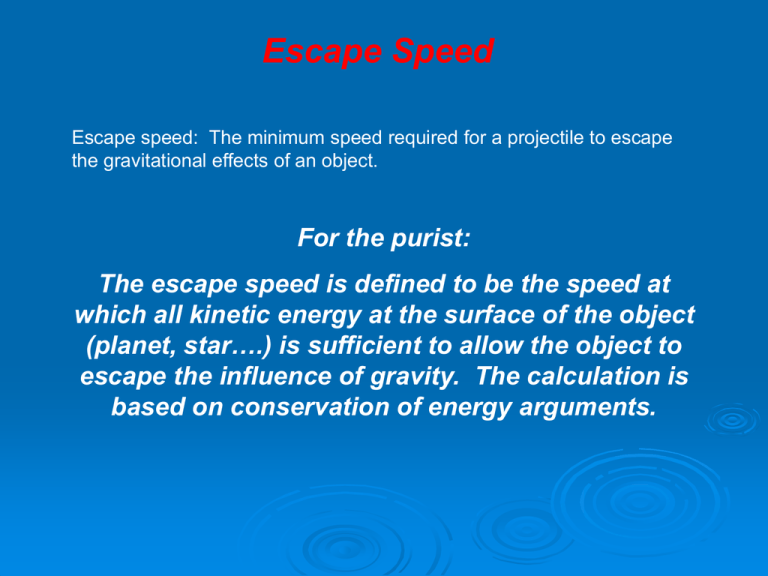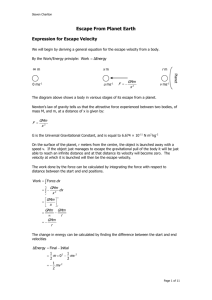Escape Speed: Physics Presentation & Calculations
advertisement

Escape Speed
Escape speed: The minimum speed required for a projectile to escape
the gravitational effects of an object.
For the purist:
The escape speed is defined to be the speed at
which all kinetic energy at the surface of the object
(planet, star….) is sufficient to allow the object to
escape the influence of gravity. The calculation is
based on conservation of energy arguments.
Escape Speed
In general:
vescape =
1/2
( )
2GM
R
Note: This looks like the relationship we have
used in the past relating masses to orbital
speeds, but watch out for the “2.”
Escape Speed
Show that the escape velocity for rockets leaving the surface of the
earth is 11 x 103 m/sec.
M = 5.97 x 1024 Kg
R = 6.378 x 106 m
vescape, earth = [{2 (6.6 x 10-11 N –m2 /kg2 ) (5.97 x 1024 Kg) } / (6.378 x 106 m) ]1/2
= 11 x 103 m/sec
Escape Speed
What is the escape velocity for a typical white dwarf?
For a white dwarf, use:
M = 2.18 x 1030 Kg
R = 5.1 x 106 m
vescape, dwarf = [{2 (6.6 x 10-11 N –m2 /kg2 ) (2.18 x 1030 Kg) } / (5.1 x 106 m) ]1/2
= 7.5 x 106 m/sec
Escape Speed
What is the escape velocity for a typical neutron star?
For a neutron star, use:
M = 3.3 x 1030 Kg
R = 2.0 x 104 m
vescape, neutron = [{2 (6.6 x 10-11 N –m2 /kg2 ) (3.3 x 1030 Kg) } / (2.0 x 104 m) ]1/2
= 1.4 x 108 m/sec
Escape Speed
Interesting piece of information: IF the earth (magic?) could be
collapsed to a radius of 0.008756 m (just about a centimeter)
Some numbers:
From the surface of the earth,
M = 5.97 x 1024 Kg
R = 8.756 x 10-3 m
vescape, dwarf = [{2 (6.6 x 10-11 N –m2 /kg2 ) (5.97 x 1024 Kg) } / (8.756 x 10-3 m) ]1/2
vescape, earth = 3.0 x 108 m/sec










